Types and varieties
In culture, there are both annual species and varieties of lychnis, and perennial.
Likhnis chalcedony or Dawn

Popular with gardeners
In horticulture, the most common chalcedony lychnis is the Maltese cross, which is distinguished by its graceful bright red flowers.
Likhnis sparkling
The plant grows in height from forty to sixty centimeters in nature in the Far East, Japan, China, Eastern Siberia. It has light green oblong-ovate or oval-lanceolate leaves and scarlet-red flowers, collected in corymbose-capitate inflorescences.
Lychnis crown
A perennial herb in height can reach from forty to ninety centimeters. Its bright green foliage is located on ash gray shoots. The flowering of Lychnis coronae begins in late spring and continues until the frost. Dense corymbose inflorescences consist of pink, white or crimson buds.
Popular varieties of Lychnis crown:
- Mysterious island - the flowers of the plant have a white border and a pink center;
- Angela Blanche - bushes with large inflorescences of dark pink or crimson color.
Lychnis viskaria
A perennial herbaceous plant grows in Northern Europe, in the southwest of Siberia, in the Crimea and the Ciscaucasia. It differs in height from forty to one hundred centimeters, sticky stems at the top, paniculate inflorescences, which consist of five to seven white or crimson flowers.
The most popular varieties:
- terry Flore Pleno - a bush with dark green, basal linear narrow leaves up to thirty centimeters high blooms with purple terry flowers;
- Rosetta - the plant is distinguished by double bright crimson flowers.
Lychnis alpine
A compact bush up to twenty centimeters high is distinguished by basal opposite linear leaves and red-pink or crimson flowers gathered in panicles. Its popular variety, Lara, blooms with numerous flowers of pale pink color.
Lychnis Arkwright
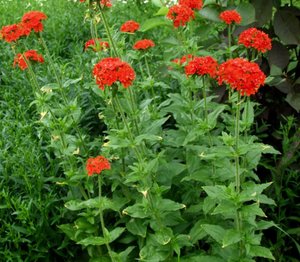
Unusual plant up to forty
Description
The carnation family has 35 species. Only 8 have taken root in Russia, mainly they grow in the south and in Asia Minor. Fiery bright flowers of chalcedony lychnis seem to glow in the garden, creating a fabulous atmosphere. A plant with a strong root, in one place it can bloom for up to five years, ornamental shrubs reach from 40 centimeters to 1 meter in height. Long, tapering leaves are distributed along the entire length of the rough stem.
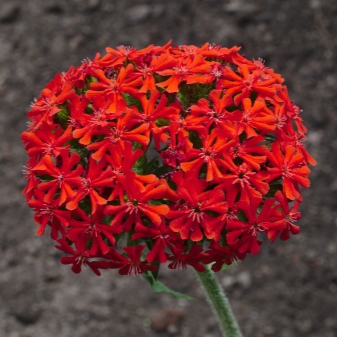
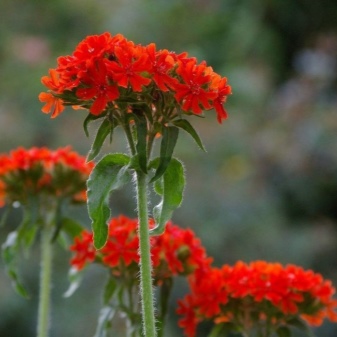
The flower and rhizome of the dawn are soaped, and when rubbed, they also foam the water. The ancestors in ancient times washed and washed things with lyhnis, it is called girlish soap. Today it is more interesting in terms of its decorativeness and brightness. Small flowers are only 2 cm in diameter, and together form a bright red ball with a volume of 10 cm.
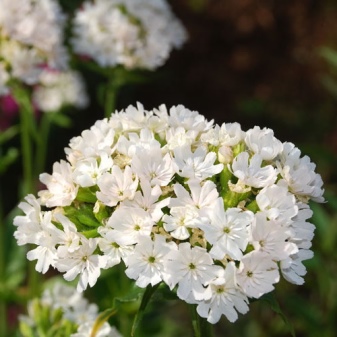

The leaves are also unusual, at the base they are heart-shaped, and at the top they are sharp.
Rules for creating a flower border in a flower bed
A variety of beautiful plants that are planted in the form of a border along the paths or in a flower bed are a favorite technique of many landscape designers. This technique is used in gardens that are laid out in a wide variety of styles.
Flowers for the border can be selected as annual and perennial. An important condition here is the planting of undersized plants so that the curb does not gradually turn into a hedge. You should figure out which low-growing flowers for the flower bed, blooming all summer, to choose for your summer cottage.
Most of the principles for creating flower borders came from the famous English gardener and landscape designer Gertrude Jekyll.She had her own garden, which amazed everyone with its skillful flower beds. Until now, many gardeners consider her work to be a model of skill and impeccable artistic taste for landscape design.
In order for a flower border to please you with its attractiveness, it is necessary not only to choose the right border plants, but also to take into account some of the subtleties of its creation.
First of all, border flowers should be in harmony with their color scheme with the main flower garden. When using perennials that bloom all summer long, you must remember that plants will definitely grow both upward and outward. Therefore, flowers need to be given a little more space.
When decorating borders, you must also remember that the gaps in the edging always look rather untidy, so it is recommended to plant the same type of plants in two rows. If we talk about the parameters of the curbs, then there are some classic standards: the height is up to 40 cm, and the width is no more than 50 cm.
It should be noted, however, that the floral border does not have to be low. Here everything will depend on the place of its application.
You can even use a variety of ornamental shrubs or annuals that are easy to cut and look pretty attractive.
When planting flowers for the border, you should also pay attention to the fact that the frame does not fall apart in different directions, it looks pretty well-groomed and neat. For this, it is recommended to choose compact flowers that are distinguished by their slow growth. The decorativeness of plants in the form of flowers or shrubs should not depend on weather conditions. Despite the rain or the scorching sun, the border flowers should look pretty attractive. To achieve this, it is recommended to choose the most unpretentious plants that are distinguished by their endurance even in conditions of limited space for development.
From the above rules, it becomes clear that the choice of plants for planting a curb is the key to creating a quality frame for your garden.
What else is important to consider
As mentioned earlier, paths, flower beds, small architectural forms can be decorated with borders. The height of such plantings in the form of flowers or shrubs can reach half a meter or be very low and even creeping. Curbs can be formed from a wide variety of plants:
- from shrubs;
- ground cover;
- herbaceous;
- conifers;
- flowering.
- Lighting;
- Soil fertility;
- Humidity;
- Neighborhood with other plants.
If you decide to arrange a border that differs in its length, it is recommended to use rather unpretentious plants.
It is important that such flowers do not grow, occupying any territory uncontrollably.
This mainly applies to perennials, since caring for these aggressive plants can turn into a constant struggle with them. When decorating, it is also necessary to take into account the duration of the flowering of the culture and the appearance of the faded plant.
Reproduction of Smolka

Seeds
For open ground, the seeds are also kept in a manganese solution. They can be sown in the fall before winter in order to get resin shoots in the spring. Autumn sowing is carried out in regions with a mild climate. To protect planting from freezing, they are sown between other already adult plants.
Spring sowing of tar is best done when the night temperature is stable. The soil is loosened before this, a little fertilizer is applied.
In early spring, seeds can be sown in a greenhouse, where they will sprout, and the mature resin seedlings can be moved to open ground in May. The plant usually blooms the next year.
Cuttings
They are cut in June, planted in the sand and covered with foil. So they take root quickly. You can treat them with root before that. Tar cuttings need regular airing and moisturizing. You can transplant them into open ground in August.
Terry resin species propagate vegetatively, they do not produce seeds.
Types and varieties of lyhnis
Many species and varieties of lychnis are grown in the culture, with which we will be happy to introduce you.
Lychnis arkwrightii
- a compact plant 35-40 cm high, the narrow leaves and stems of which are painted in a burgundy shade. Few inflorescences or single flowers about 3 cm in diameter with orange petals open at the ends of the stems at the end of June and bloom until mid-August. The most famous variety of the species:
- Lychnis Vesuvius - a plant with wide heart-shaped bright green leaves and inflorescences of orange-red flowers denser than those of the main species.
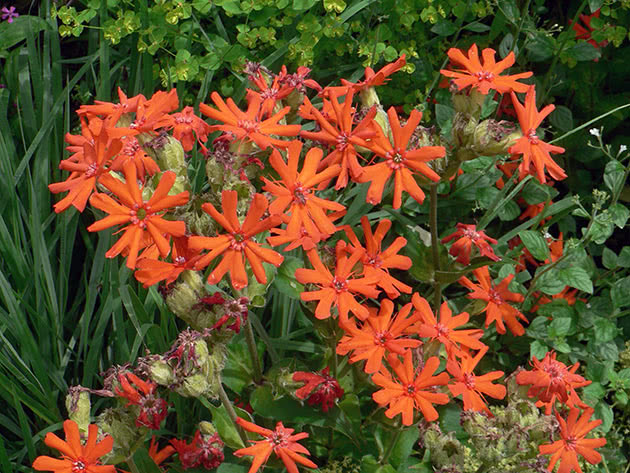
Lychnis alpine (Lychnis alpina = Viscaria alpine = Steris alpine)
inhabits the forest-tundra and tundra of Scandinavia, the east of North America and Greenland, as well as the alpine and mountain-tundra belts of Europe. It is a perennial 10-20 cm high with basal rosettes of leaves and several stems with linear opposite leaves. The flowers of this species are crimson or red-pink, collected in panicles. Popular variety:
- Lara is a plant with numerous pale pink flowers.

Lychnis viscaria (Viscaria vulgaris = Lychnis viscaria = Silene viscaria)
distributed in the Ciscaucasia, Crimea, in the south-west of Siberia, in Central Europe. The stems of this herbaceous perennial reach a height of 40 to 100 cm, in the upper part they are sticky, for which the plant is called tar. The flowers of the viscarias are crimson or white, collected in 5-7 pieces in whorls, forming a paniculate inflorescence. Popular are:
- - Lyhnis Rosetta - a variety with bright crimson double flowers;
- - lychnis terry flora Pleno - a plant up to 30 cm high with narrow linear basal leaves of a dark green hue and purple double flowers 2-3 cm in diameter forming a brush.

Lychnis crown (Lychnis coronaria = Lychnis coriacea)
- a herbaceous perennial plant, reaching a height of 40 to 90 cm. It forms loose clusters of pink flowers, although sometimes there is also a white crown lichnis. The best varieties:
- - Angels Blanche - a variety with white, dark pink or crimson flowers;
- - Mysterious Island - a plant with flowers with a pink center and a white border around the edge of the petals.
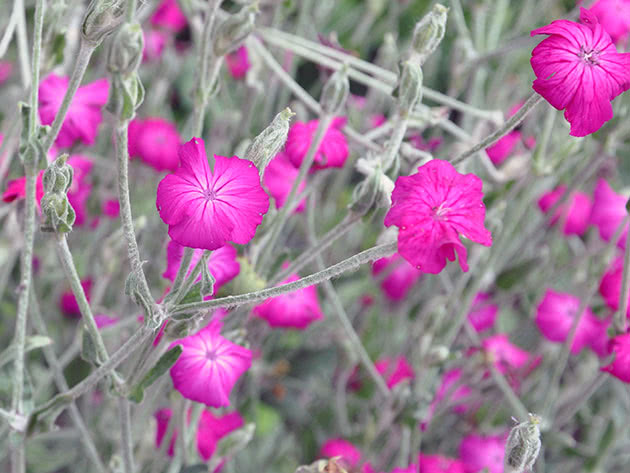
- - Nana - a plant with a height of only 15 cm;
- - Alba - a variety with white flowers;
- - Rosea captivity - pink lychnis, terry.
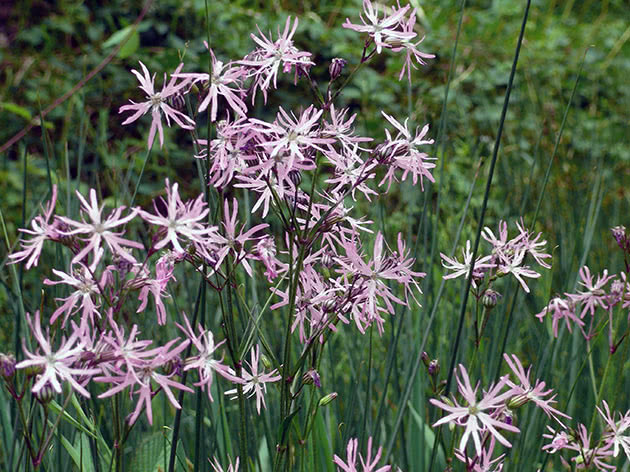
Lychnis sparkling (Lychnis fulgens)
originally from Eastern Siberia, China, Japan and the Far East. In height, the straight stems of this species reach 40-60 cm. Lichnisus has sparkling oval-lanceolate or oblong-ovate light green leaves and scarlet-red flowers collected in corymbose-capitate inflorescences 4-5 cm in diameter with petals divided into 4 parts.
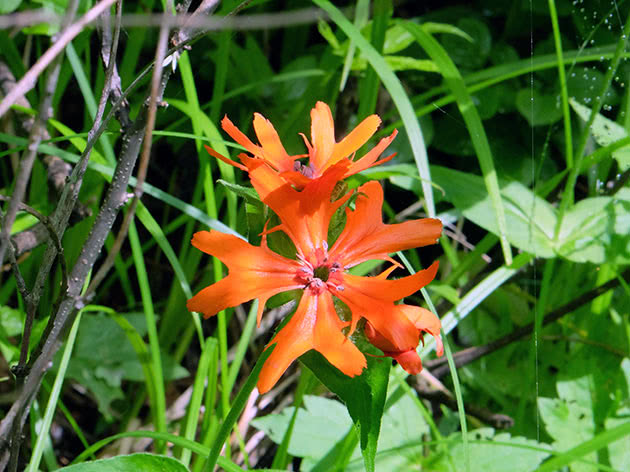
Lychnis Haage (Lychnis x haageana)
Is a garden hybrid 40-45 cm high with oblong-ovate leaves, red-orange flowers up to 5 cm in diameter, collected in 3-7 pieces in a brush. The flower petals are deeply incised, with a bend, on each side they have a narrow long tooth. The species is winter hardiness. The most famous variety of the species:
- Molten Lava is a plant with bronze leaves and bright red flowers gathered in umbrellas.
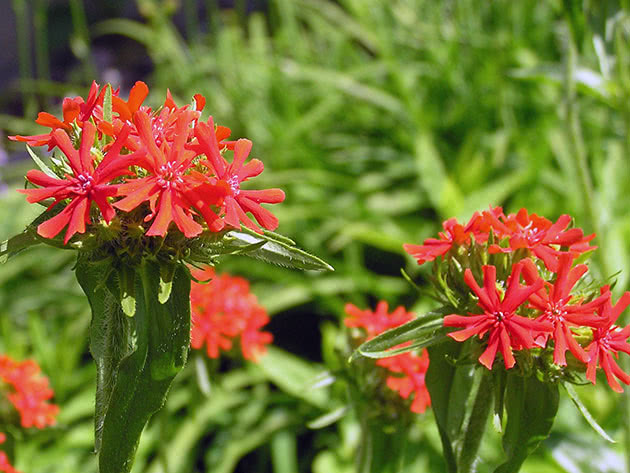
- lyhnis Maltese cross - a lush flowering plant with bright red flowers of graceful shape.
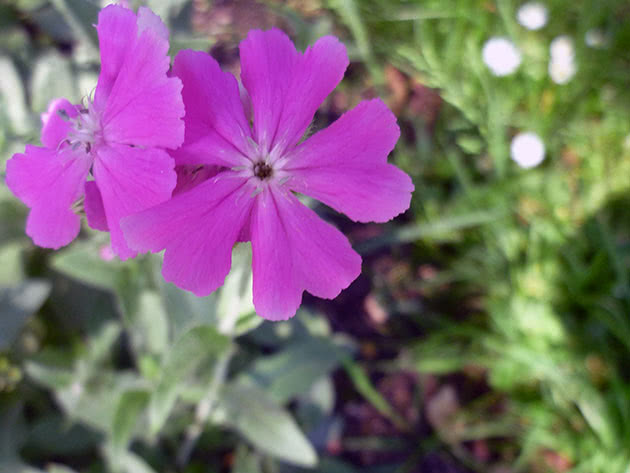
Lychnis Jupiter (Lychnis flos-jovis = Coronaria flos-jovis)
in nature, it grows on the slopes of the Alps, forming loose bushes up to 80 cm high. The stems of plants of this species are densely leafy, branched, the leaves are lanceolate-oval, pubescent, like the stems. The flowers are light purple, simple, up to 3 cm in diameter, but the Lychnis Jupiter has a double and white-flowered form.
Landing rules
Derain is not too picky about planting, so gardeners, even beginners, do not face problems. You can plant shoots both in well-lit and slightly darkened areas.
It should be borne in mind that variegated varieties with a large amount of shade can lose their amazing color during the day.
Any of the selected varieties of deren quickly adapts to the created conditions, this is another advantage of the plant. There are only a few varieties that are not very hardy, so they will need to be covered while they are young.As for watering, the plant can withstand a prolonged absence of rain, but there are also varieties in which the root system is on top, they need to be watered more often.

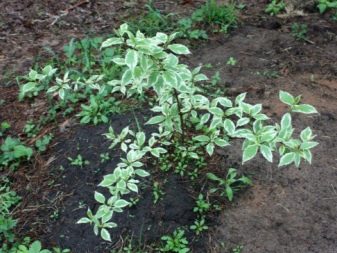
It is very good if the gardener is not lazy and regularly starts feeding the plant. The dogwood will quickly respond to such care and attention with dense vegetation and a large number of fruits. The most successful planting is considered in soil with a low pH.
But the lawn does not like frequent interference around the plant in the soil, since its root system suffers from this. This is one of the reasons why it is not worth ripping too often.
Before planting, the pit should be prepared in advance. If you plan to plant several plants next to each other, then the distance should be at least 700 mm. If this is a young shrub, then the depth of the pit is up to 500 mm. The root collar must be deepened by 3 centimeters. If planting is done on loamy soil, then you will need to additionally pour compost, fertilizer or humus inside the pit. You can use a mixture of peat and sand.
The ideal combination is considered to be 2 parts of compost and sod land and 1 each of sand and peat. From fertilizers, you can add 100 grams of dolomite flour, superphosphate or wood ash. If the soil is peat, then the amount of dolomite flour should be doubled.
After the seedling is laid in the ground and covered with earth, you will need to tamp the soil around a little. There should be no voids in the area where the root system is located; in order to remove them, the plant is watered.
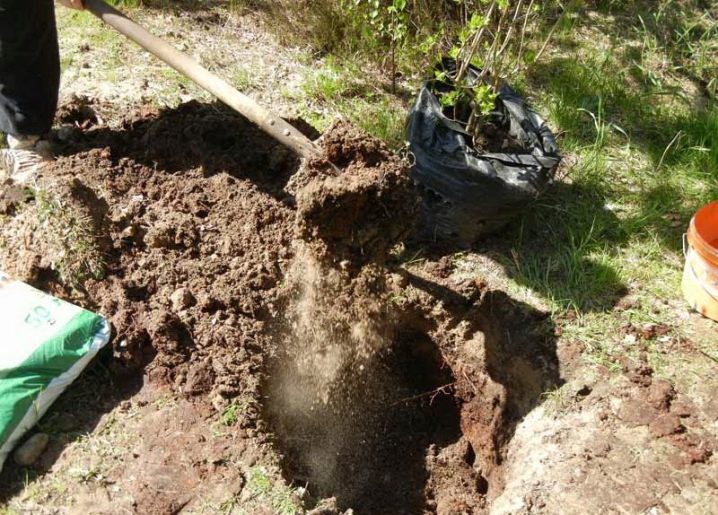
It is best used for planting shrubs up to five years old, which are supplied in containers. The main thing is not to disturb the root system, for this, the grass is removed from the package very carefully and, with the available soil, is immersed in the planting pit. Every gardener must remember that despite the fact that the dogwood is picky, it will hurt if the depth of the pit is insufficient. It is impossible that the root system is even partially bare.
The best time for planting seedlings is early spring. During the warm months, the bush will have time to adapt and prepare for the subsequent wintering. Before you immerse the seedling in the hole, you need to trim its roots a little.
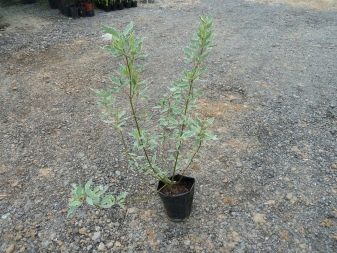
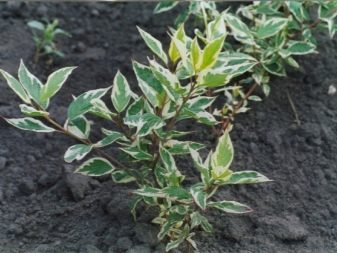
The role of red in the composition of the garden
Items highlighted in red are usually the first to catch the eye, even if they are in the background. In painting, red often denotes priority details that are important for understanding the meaning of the work. Red plays a similar role in the garden, denoting key points, lines, planes, as if directing the movement of the observer's eyes.
You can imagine planting red annuals as an excretory marker with which it is convenient to circle, emphasize, indicate what deserves it from your point of view. For example, even small windows, when decorated with red colors, become more meaningful and expressive, thanks to which even a dimmed facade of a house makes a better impression.
Flower beds of red annuals give the garden neatness, elegance, look more well-groomed
Red masks the sparseness of plantings, spots on the petals, dried inflorescences - in red flowers they do not attract attention so much
How and when to plant
Lychnis crown can reproduce in several ways. Seed and vegetative propagation remains the most effective.
Cuttings
It must be performed in June. To do this, cut off curved shoots from an adult bush with a knife. Their length should be 20 cm. For rooting, it is necessary to plant a cutting in a greenhouse. If this is not possible, then it is enough to cover it with a film. The roots will appear at the seedling closer to autumn.
Already rooted plants can be planted in a permanent place. This will also be done in the fall. Cuttings must be chosen for varieties with double flowers.The plant obtained in this way will fully convey the varietal characteristics. But how Budleia propagates by cuttings, and how to do it correctly, in great detail, and in detail, is described in this article.
Dividing the bush
If you decide to choose this breeding method, then you need to pick up a well-grown bush. To do this, he must be at least 4 years old. Divide it into several parts. You can take up to 5 new seedlings from one bush.
When you divide the bush, you need to be very careful. It is worth separating so as not to injure the root system.
Thus, the culture quickly gets used to new conditions and begins to grow actively. Autumn is perfect for this type of breeding. It is necessary to plant divided specimens at a distance of 20 cm from each other. And here is how the division of Likhnis Rosetta takes place, this information will help to understand.
But how to plant Asters with seeds will help you understand the video and information from this article.
It will also be interesting to see how the Astra Pompon mixture looks like.
You may also be interested to see what the flower of the Alpine Aster looks like.
Seed propagation
Lychnis crown allows you to get decent self-seeding. When young seedlings appear, only the most durable ones choose them. Then put them in a permanent place. The planting material has excellent germination capacity. Seeds can even grow 4 years ago. They will be sown in open ground in April-May.
They germinate at a temperature of 18 degrees. It will be possible to see the first shoots 21 days after sowing.
If you need to accelerate the germination of planting material and get friendly shoots, then it is worth stratifying it for 30 days. For this, the seeds are stored in a cold place. The bottom shelf of the refrigerator works best. If the seeds are not stratified, then their germination can be accelerated by covering the area with agrofibre or film. But when to sow Lupine seeds for seedlings, the information from the article will help to understand.
On the video - the reproduction of Lychnis by seeds:
When the seedlings appear, and 2-3 leaves are formed, then you can make a pick and plant chi in a permanent place. Flowering can be observed for 2 years. You can sow seeds in summer. To do this, you have to prepare a container, fill it with nutrient soils. Cover plantings with foil to create a thermal effect. When the first shoots appear, the shelter can be removed.
Move the container with seedlings to a shady place. If the sun shines on the plants, it can burn them. By the end of summer, the seedlings will grow and become strong. Then they can be dropped off at a permanent place. You can expect flowering next year.


